Gallery Images
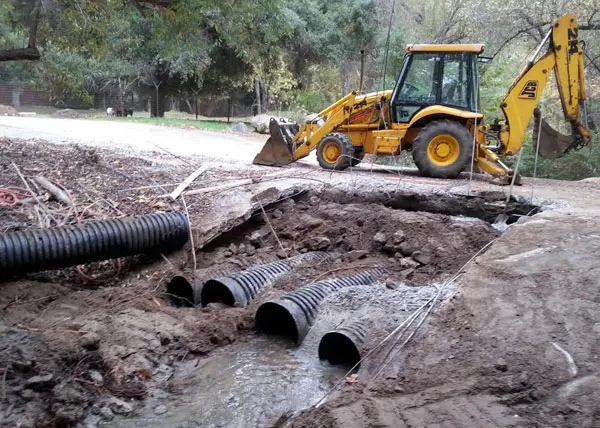 This is an Arizona bridge repair in De Luz, CA. Old rusted out steel culvert pipe have been replaced with plastic pipe. Now the concrete work can begin.
This is an Arizona bridge repair in De Luz, CA. Old rusted out steel culvert pipe have been replaced with plastic pipe. Now the concrete work can begin. These leach lines in Sage, CA are made with infiltrator chambers that are connected together in a three foot wide trench. These lines were installed on the contour of the slope to avoid the rock outcroppings prevalent in this region.
These leach lines in Sage, CA are made with infiltrator chambers that are connected together in a three foot wide trench. These lines were installed on the contour of the slope to avoid the rock outcroppings prevalent in this region. This is the completed Arizona bridge in the DeLuz area of Temecula, CA. Aztec Septic and Excavation made sure that the the seasonal flow passes through the culverts. The bridge is designed so that in periods of high flow the water goes up and over to prevent washout.
This is the completed Arizona bridge in the DeLuz area of Temecula, CA. Aztec Septic and Excavation made sure that the the seasonal flow passes through the culverts. The bridge is designed so that in periods of high flow the water goes up and over to prevent washout. This home pad in Rainbow, CA had to be dug out to remove undocumented fill and refilled and compacted with clean material. Rock had to be jackhammered out on the uphill side, removed and replaced with two feet of clean dirt so the entire house would rest on level material.
This home pad in Rainbow, CA had to be dug out to remove undocumented fill and refilled and compacted with clean material. Rock had to be jackhammered out on the uphill side, removed and replaced with two feet of clean dirt so the entire house would rest on level material.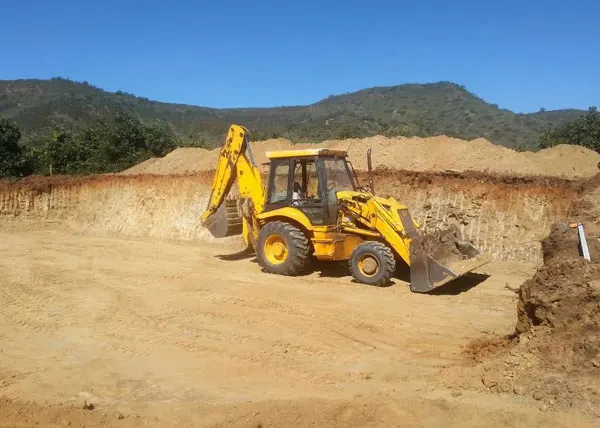 Aztec Septic completed dirt work featuring a dig out for a daylight basement for this future home in Temecula, CA. The home has been engineered for an ATU septic system. If you look closely, you can see the rock layer under the topsoil making this Deluz home's ATU septic system a practical choice over conventional leach lines or seepage pits. This Temecula, CA home will be one story in front and two in back.
Aztec Septic completed dirt work featuring a dig out for a daylight basement for this future home in Temecula, CA. The home has been engineered for an ATU septic system. If you look closely, you can see the rock layer under the topsoil making this Deluz home's ATU septic system a practical choice over conventional leach lines or seepage pits. This Temecula, CA home will be one story in front and two in back. Aztec Septic and Excavation installed this ATU system in Murrieta, CA. A control panel mounted on the house runs this mini sewer system. The nearest septic tank is a three compartment tank. The first stage is solid chamber followed by an aeration chamber and filter stage. The round tank is a dosing tank. This houses a pump with three control floats. The effluent is pumped by timed doses into a pressurized drip field.
Aztec Septic and Excavation installed this ATU system in Murrieta, CA. A control panel mounted on the house runs this mini sewer system. The nearest septic tank is a three compartment tank. The first stage is solid chamber followed by an aeration chamber and filter stage. The round tank is a dosing tank. This houses a pump with three control floats. The effluent is pumped by timed doses into a pressurized drip field.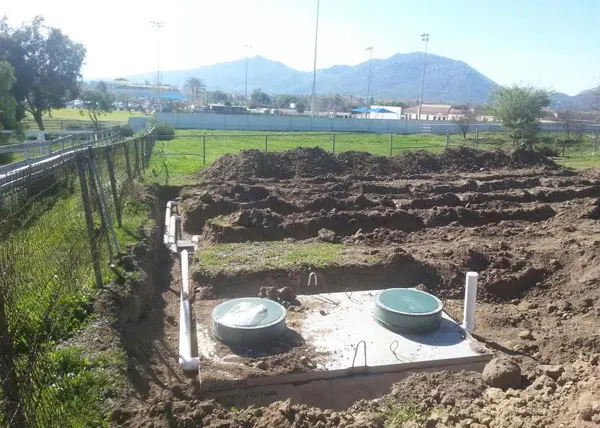 This is a new septic system installation in the Los Ranchitos area of Temecula, CA. This septic tank installation features a 1000 gallon concrete tank with the risers and lids already installed. The tight line coming off the septic tank going to the distribution box feeds the four leach lines. While this septic system is uncovered it will be inspected. At that point, the earth will be put back and smoothed out. This septic tank installation was completed for a homeowner's guest house.
This is a new septic system installation in the Los Ranchitos area of Temecula, CA. This septic tank installation features a 1000 gallon concrete tank with the risers and lids already installed. The tight line coming off the septic tank going to the distribution box feeds the four leach lines. While this septic system is uncovered it will be inspected. At that point, the earth will be put back and smoothed out. This septic tank installation was completed for a homeowner's guest house.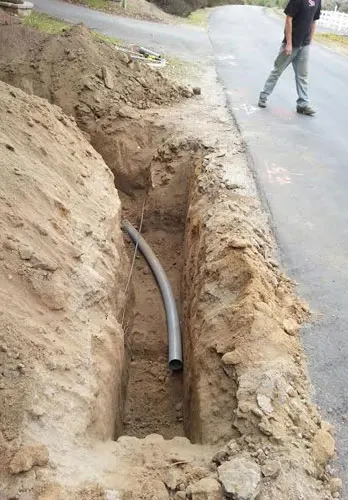 This trench in Temecula, CA has a 90 degree bend with a twelve and a half foot radius. This is required by Edison to reduce the friction when pulling the wire through for service.
This trench in Temecula, CA has a 90 degree bend with a twelve and a half foot radius. This is required by Edison to reduce the friction when pulling the wire through for service.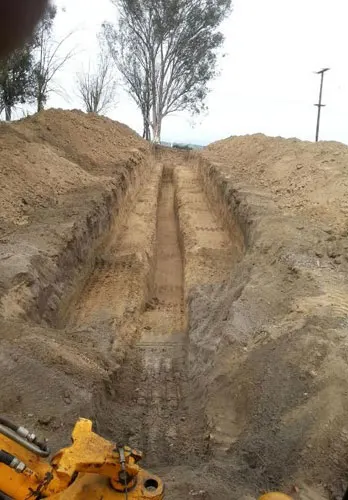 We dug this fault trench in Lake Elsinore, CA. The fault trench is about ten feet wide and ten feet deep and is dug to find fault lines under the surface of the property. These exploratory trenches will determine where development will be allowed above ground.
We dug this fault trench in Lake Elsinore, CA. The fault trench is about ten feet wide and ten feet deep and is dug to find fault lines under the surface of the property. These exploratory trenches will determine where development will be allowed above ground.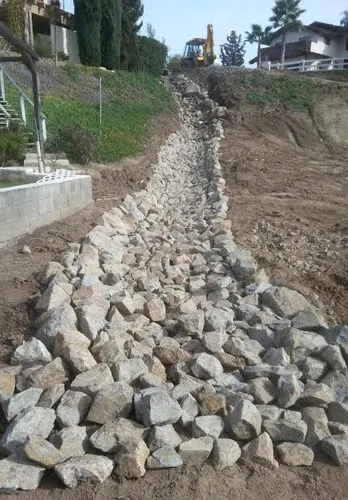 We built a water course and lined it with rock to divert the water and stop erosion in this Temecula, CA residential community. This new house being built in Meadowview will have a seepage pit septic system. The seepage pit septic system will prevent drainage water from flowing at random. This rock will be made permanent by grouting the rock with a cement slurry.
We built a water course and lined it with rock to divert the water and stop erosion in this Temecula, CA residential community. This new house being built in Meadowview will have a seepage pit septic system. The seepage pit septic system will prevent drainage water from flowing at random. This rock will be made permanent by grouting the rock with a cement slurry.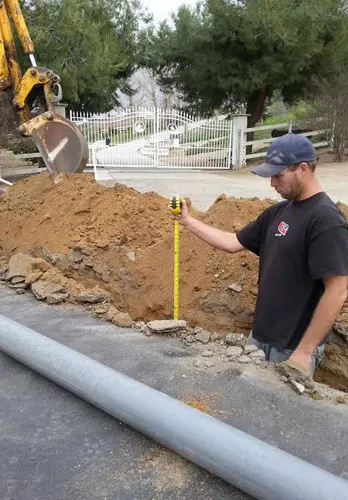 In Temecula, CA, Aztec Septic ran a four inch conduit for Edison from an existing transformer. A two inch conduit for a telephone was also run from a communication pedestal along a road to a new house. Dry utilities can go in a common trench as long as certain separations are met. Edison for instance, wants a twelve inch separation from other conduits and at least a thirty inch cover.
In Temecula, CA, Aztec Septic ran a four inch conduit for Edison from an existing transformer. A two inch conduit for a telephone was also run from a communication pedestal along a road to a new house. Dry utilities can go in a common trench as long as certain separations are met. Edison for instance, wants a twelve inch separation from other conduits and at least a thirty inch cover.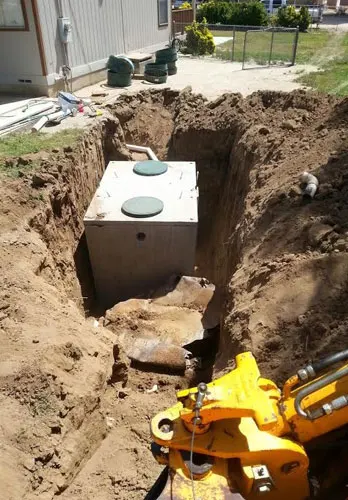 In a septic tank replacement in Menifee, CA, Aztec Septic and Excavation found an old steel septic tank that had rusted through. The old tank was pumped out and crushed and we enlarged the hole in the ground to make room for a new concrete septic tank. The new tank is then plumbed to the house and to the leach field. This system happened to be leach lines versus seepage pits.
In a septic tank replacement in Menifee, CA, Aztec Septic and Excavation found an old steel septic tank that had rusted through. The old tank was pumped out and crushed and we enlarged the hole in the ground to make room for a new concrete septic tank. The new tank is then plumbed to the house and to the leach field. This system happened to be leach lines versus seepage pits.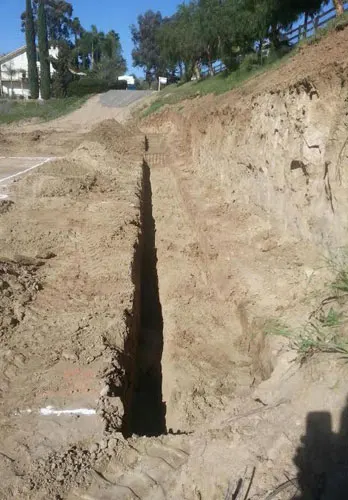 This is a footing for a retaining wall in the Meadowview area of Temecula, CA. This retaining wall will also be a structural wall for a house. In the shadow of this footing is a one foot wide "key" that is three feet deep. A soils engineer designs the footing based on retention and other factors. This footing will retain approximately nine feet of earth behind the wall. Due to a small amount of usable land and a good perk rate deeper in the soil, this Temecula, CA home was designed to incorporate seepage pits.
This is a footing for a retaining wall in the Meadowview area of Temecula, CA. This retaining wall will also be a structural wall for a house. In the shadow of this footing is a one foot wide "key" that is three feet deep. A soils engineer designs the footing based on retention and other factors. This footing will retain approximately nine feet of earth behind the wall. Due to a small amount of usable land and a good perk rate deeper in the soil, this Temecula, CA home was designed to incorporate seepage pits.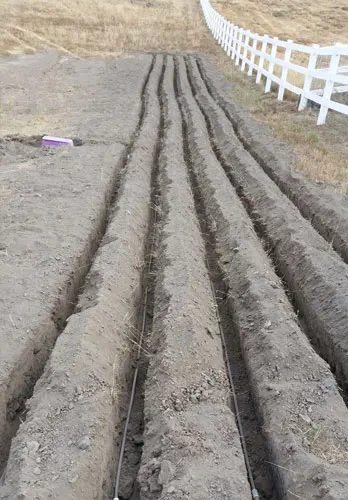 This is a pressurized drip field for an ATU system in the Deluz area of Temecula, CA. Since a conventional septic system with leach lines or seepage pits could not be used due to high ground water and water course setbacks, an ATU system was installed. This field here are trenches two feet on center and one hundred feet long. In a ATU system, the effluent is treated with oxygen so that it is clean enough to be dispersed in one foot of soil. At this depth the soil can lose most of the water through evaporation.
This is a pressurized drip field for an ATU system in the Deluz area of Temecula, CA. Since a conventional septic system with leach lines or seepage pits could not be used due to high ground water and water course setbacks, an ATU system was installed. This field here are trenches two feet on center and one hundred feet long. In a ATU system, the effluent is treated with oxygen so that it is clean enough to be dispersed in one foot of soil. At this depth the soil can lose most of the water through evaporation.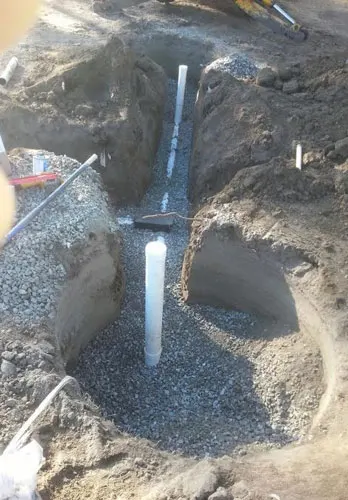 Here is an example of two seepage pits that have been drilled and installed in the Meadowview area of Temecula, CA. Both seepage pits are five feet in diameter with a total depth of twenty feet. The black box you see in between the two standpipes is the distribution box. Since the inlet depth is about three feet below grade the effective working seepage pit would be seventeen feet below inlet (BI). Seepage pits are a good choice for a leach field over leach lines in the case absorbent earth is found below the ground’s surface. Some areas of Temecula such as Meadowview and the Wine Country are where we commonly create seepage pits due to the absorbent soil. To make the seepage pit, we start with a five or six foot diameter hole drilled in the ground. The hole is then lined with brick or pre-cast concrete rings and three quarter chip rock is used to backfill between the liner and the earth. A concrete ring is placed on top of the liner. This ring has an access port for the discharge line. Seepage pits have a much smaller footprint than leach lines and can be installed in driveways.
Here is an example of two seepage pits that have been drilled and installed in the Meadowview area of Temecula, CA. Both seepage pits are five feet in diameter with a total depth of twenty feet. The black box you see in between the two standpipes is the distribution box. Since the inlet depth is about three feet below grade the effective working seepage pit would be seventeen feet below inlet (BI). Seepage pits are a good choice for a leach field over leach lines in the case absorbent earth is found below the ground’s surface. Some areas of Temecula such as Meadowview and the Wine Country are where we commonly create seepage pits due to the absorbent soil. To make the seepage pit, we start with a five or six foot diameter hole drilled in the ground. The hole is then lined with brick or pre-cast concrete rings and three quarter chip rock is used to backfill between the liner and the earth. A concrete ring is placed on top of the liner. This ring has an access port for the discharge line. Seepage pits have a much smaller footprint than leach lines and can be installed in driveways.




